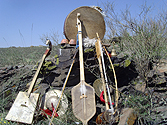|
 Tuvan national instruments became the foundation of the Siberian collection of the State ethnographic museum of Warsaw. The museum obtained 2 igils and 2 byzaanchy – handcrafted bowed string instruments, as well as a shamaness’ costume from the collection of ethnic costumes in possession of the Tuvan artists who are now on tour throughout Europe in the framework of the presentation program “Regions of Russia. Republic in the center of Asia – Tyva.” Tuvan national instruments became the foundation of the Siberian collection of the State ethnographic museum of Warsaw. The museum obtained 2 igils and 2 byzaanchy – handcrafted bowed string instruments, as well as a shamaness’ costume from the collection of ethnic costumes in possession of the Tuvan artists who are now on tour throughout Europe in the framework of the presentation program “Regions of Russia. Republic in the center of Asia – Tyva.” As Adam Chizhevskii, director of the museum, explained to the special detachment of “Tuvinskaya Pravda” accompanying the tour, he spent the entire year’s reserve of the director’s fund for this purchase.
The performances of the presentation of Tuva in European countries as a unique and original national subject of RF started on the first days of March. The presentations have already been performed in Finland, Poland and Austria at the Russian centers of Science and Culture. Today the Tuvan delegation arrived in Berlin, where the concerts of Tuvan artists will take place, and the exhibitions of decorative applied art and craft, photographs of Tuva, and ritual paraphernalia of shamans.
In the framework of this action, there are photographic exhibitions “Tuva in early 20th Century”, exhibition “Archeology of kurgan “Arzhaan-II” of the Scythian period”, exhibitions of souvenirs and folk attire, and “Religions in Tuva”, which includes the exposition of ritual paraphernalia of shamanism. The Tuvans brought to Europe a multifaceted cultural program as well. In it, Tuvan folk dances are introduced, and a show of stage costumes is demonstrated, worn by the young members of the “Edegei” dance ensemble. The ensemble “Khogzhumchu” performs traditional throat singing khoomei – the pearl of Tuvan culture.
The action received extremely positive response by the audiences in the countries visited by the Tuvans. “I am astonished by the high level of the art! I often go to the institute of Russian culture, but I have never seen something so magnificent. All the highest praise to the craftswomen who made the costumes. Currently there is a lot of interest in shamanism in the West. People go to consult shamans. It is a return to Nature, an appeal to the natural forces. I have a friend, a Frenchwoman, who often goes to Tuva. We went together to the performances of Galsan Tschinag, where we were first introduced to Tuvan language. But at that time there was no music, no picturesque costumes. I hope that we will meet often, - shared Riva Ryudisser, a reporter of the radio “Svoboda”.
“We have a Russian song ensemble “Kumushki”, folk and contemporary songs. Almost all of us have come to hear you. And we are in total rapture, because nobody sings like this here, and it was very interesting. I used to listen to throat singing as a child, when the Soviet radio would broadcast the music of all the 15 republics,” – said Olga Klykova. Her husband, Viktor Klykov, a member of the co-ordination council of compatriots in Austria, added: “In the future, if there are any actions connected with Tuva, we will definitely come and bring friends. At least we have some idea about your culture, but for Austrians it is a completely unknown world.”
After Germany, the Tuvan representatives will be welcomed in Belgium, France, and Spain.
|
|
